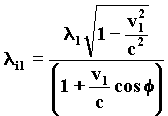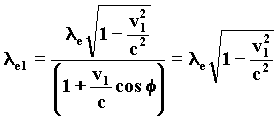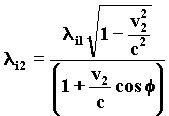The wave description of the Compton effect
We can verify the hypotheses and the laws deriving from the new wave theory, by using the Relative Symmetry Principle and the wave changes in the General Relativity, for a new purely wave interpretation of the simplest phenomenon of interaction between matter, in the form of elementary particle (electron), and the most elementary radiation (photon) in the Compton effect.Letís observe, in four times, an ideal experiment of Compton interaction with a photon having li as a wavelength
li = 1ē10-10 m diverted by 90° by a free electron, in a space deprived of significant fields.1) the photon gets closer to the source of the field of the electron, and its energy is added to the one of the waves of the field of the electron in the A zone:
50)


Fig. 11Because of the wave variation, the Relative Symmetry Principle obliges the electron to the motion, imposing the v1, velocity on it.
from 15) we draw the v1, velocity. It follows that:
51)Letís consider the frame of reference of the electron-source of waves that moves with the v1 velocity. Observing the incident photon, we notice a decay due to Doppler effect, as resulting from the following formula, where the angle of incidence Ø of the photon compared to the direction of the velocity of the electron is p.
52)
After the decay, the photon is diffracted a = p/2, by the spherical field of waves of the electron, in compliance with the G.R. modified formula, considering the first part insignificant.
53)
for










